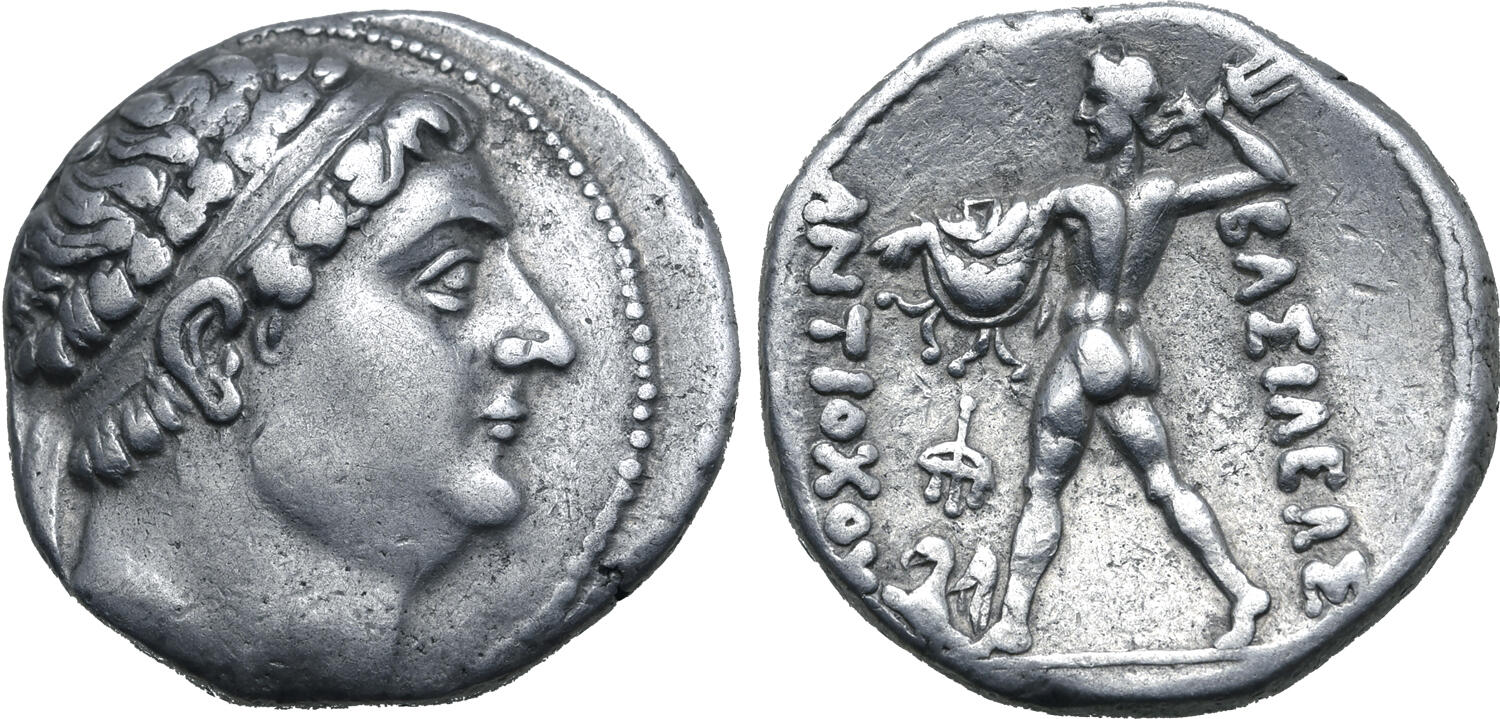S 850 - Bactria (uncertain mint) (Diodotus I), silver, tetradrachms (255-235 BCE) Bordeaux
From SILVER
255 BCE - 235 BCE Silver 18,551 kg
Description
| ObverseInscription or printing placed on the obverse.: | Head of king Diodotus right, wearing diadem. Border of dots. |
| ReverseInscription or printing placed on the reverse.: | ΒΑΣΙΛΕΩΣ ΑΝΤΙΟΧΟΥ (Greek).Zeus left, naked, aegis on left arm, brandishing thunderbolt. At feet, eagle. In field, a monogram (and a letter). All within border of dots. |
Mint and issuing power
| MintIdentifies the place of manufacture or issue of a numismatic object.: | Bactria (uncertain mint) | Ancient regionAncient region.: | Bactria | Modern countryModern country: Afghanistan | AuthorityIdentifies the issuing power. The authority can be "pretended" when the name or the portrait of X is on the coin but he/she was not the issuing power. It can also be "uncertain" when there is no mention of X on the coin but he/she was the issuing power according to the historical sources: | Bactrian kingdom, Diodotus I of Bactria (Seleucid satrap and king in Bactria, c. 255/50-239 BC) |
Chronology
| FromIdentifies the initial date in a range assigned in a numismatic context. | 255 BCE | toIdentifies the final date in a range assigned in a numismatic context.. | 235 BCE | PeriodTime period of the numismatic object.: Hellenistic 323-30 BC |
Physical description
| MetalThe physical material (usually metal) from which an object is made.: | Silver |
Median weightMedian of the weights of numismatic objects (in grams). in grams | 16.80 | DenominationTerm indicating the value of a numismatic object. Examples: tetradrachm, chalkous, denarius.: | tetradrachm |
StandardStandard.: | Attic |
Image

S2057 Diodotus tetradrachms.jpg [1]
References
| Die study referencePublication of the study: | Bordeaux 20181Bordeaux 2018, p. 151-167, n° 1-85, 89-97, 100, 198-206, 294-307, 310-311, 314, 316, 322-324, 327-329, 331-333, 382-411, 414-415, 419-423, 425-428, 444-446, 453-454, 461-465 | ||
| Coin series referenceReference to coin series study: | |||
Obverse dies distribution
| FrequencyFrequency of specimen in distribution. ᵖ | Number of obversesNumber of obverse dies. ᵖ (o) | % (o) | Number of coinsNumber of coins. (n) | % (n) | Die nameName(s) of the die(s). |
| 1 | 24 | 51.06 | 24 | 13.19 | 1, 4, 8, 9, 10, 11, 12, 18, 19, 22, 25, 27, 28, 35, 37, 38, 39, 40, 41, 42, 43, 44, 45, 46 |
| 2 | 5 | 10.64 | 10 | 5.49 | 14, 15, 17, 34, 36 |
| 3 | 3 | 6.38 | 9 | 4.95 | 26, 29, 47 |
| 4 | 2 | 4.26 | 8 | 4.4 | 21, 23 |
| 5 | 4 | 8.51 | 20 | 10.99 | 16, 31, 32, 33 |
| 6 | 1 | 2.13 | 6 | 3.3 | 24 |
| 7 | 2 | 4.26 | 14 | 7.69 | 6, 20 |
| 11 | 1 | 2.13 | 11 | 6.04 | 3 |
| 12 | 1 | 2.13 | 12 | 6.59 | 30 |
| 13 | 1 | 2.13 | 13 | 7.14 | 7 |
| 15 | 1 | 2.13 | 15 | 8.24 | 13 |
| 16 | 1 | 2.13 | 16 | 8.79 | 5 |
| 24 | 1 | 2.13 | 24 | 13.19 | 2 |
| Total | 47 of 47 | 100.02 | 182 of 182 | 100 |
Reverse dies distribution
no distribution is available
Quantification
| Number of obversesNumber of obverse dies. ᵖ (o) | 47 | Number of singletons (o1)The number of singleton coins. ᵖ | 24 |
| Number of reverse diesNumber of reverse dies. (r) | 130 | Number of coinsNumber of coins. (n) | 182 |
| Coins per obverse dieNumber of coins per obverse die. (n/o) | 3.87 | Coins per reverse dieNumber of coins per reverse die. (n/r) | 1.4 |
| Reverse per obverse ratioRatio of obverse dies divided by reverse dies. (r/o) | 2.77 | Percentage of singletons (o1)number of coins (n) divided by the number of singletons (o1) ᵖ | 51.06 % |
| Original number of dies (O) (Carter 1983 formula)The estimation of the number of coins according to Carter 1983 ᵖ | 55.21 | Coins struck if 20,000 as average productivity per dieCoins made if the average productivity for obverses (according to Carter) is 20,000. ᵖ | 1,104,200 |
| Original number of dies (O) (Esty 2011 formula)The estimation of the number of coins according to the singleton formula in Esty 2011 ᵖ (O) | 63.36 | Survival rate if 20,000 as average productivity per dieSurvival rate if average productivity is 20,000. ᵖ | 0.00016 |
| Coverage (o = % of O) (Esty 1984 formula)Esty 1984 - coverage (% of O) ᵖ (o = % of O) | 86.81% | Die productivity if survival rate 1/2,000Average productivity if survival rate is 1/2,000. ᵖ | 6,593.01 |
| Weight of silver (in kg) if 20,000 coins per die (O = Carter formula)Carter 1983 * Median weight * 20000 (*10 if gold or electrum) ᵖ | 18,551 kg <br /> 18,551 kg | Die productivity if survival rate 1/5,000Average productivity if survival rate is 1/5,000. ᵖ | 16,482.52 |
Remarks
References
- ^ Bordeaux, Olivier (2018), s (IIIe s. a.C.-Ier s. p.C.), Numismatica Antiqua 8, Bordeaux, 326 p.